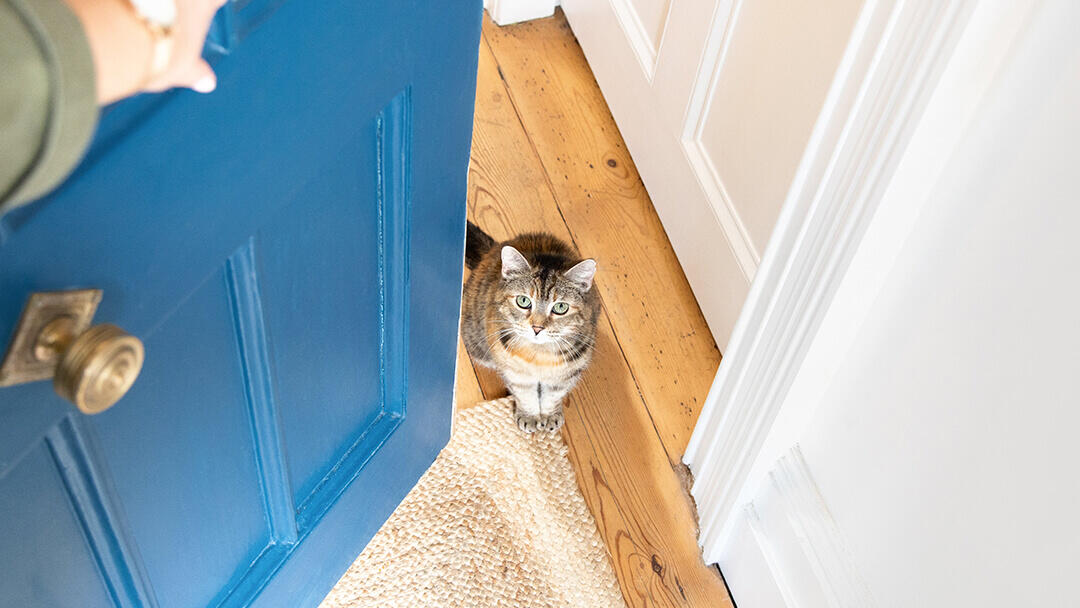
With all the dangers of modern urban life, more and more cat owners are opting to keep their felines permanently at home. Providing cats get plenty of opportunities for mental and physical enrichment, most will adapt well to living life as a house cat, but some will be less happy with this arrangement and will stare longingly at the window, begging to be let out.
For those with the space to do it, the answer is often to build a catio – a fully enclosed area in the garden linked to the door with a cat flap or tunnel, full of enrichment opportunities so your cat can get fresh air and experience all the sights, sounds and smells of the great outdoors safely. For others, enclosing the garden in cat proof fencing (yes it does exist – at a cost!) can be another great option.
Many owners however are now considering walking their cat on a lead to offer them a safe way to explore the great outdoors and if done properly, it can be a great way for them to exercise and enrichment – even though it doesn’t replace a cat’s natural instincts to explore independently.
Some cats really enjoy this (usually the very confident felines) – which others look on it as some kind of torture or just really stressful but if you think your cat might be in the former category, before you take to the great outdoors, you need to train them first.
Find out how to lead train a cat and get our top tips in this guide.
How to lead train a cat
First things first, it’s important to note that walking a cat on a lead is very different to how it is with a dog. Expect it to be a much slower experience, both with training them and then when you go out and about for walks.
Where dogs will be led by you and will trot along happily, occasionally stopping for a sniff, a cat will lead the walk and may want to stop to bask in the sun, play with a bug and then may even go for an excitable sprint! In other words, you go where they want and the lead is just for safety.
If you’re prepared to let your feline lead the way, here are our top tips for lead training a cat:
Step 1: get the right equipment
Before you begin the training process, you’ll need to get the right equipment to ensure your kitty is safe and comfortable on their adventures. Here’s what you’ll need:
A specialist cat harness: this will need to be well fitted to your cat (you should be able to fit one or two fingers beneath the harness). Using a small dog harness is absolutely not suitable as cats are built very differently – and you need one that your cat can’t wriggle out of (and they can be surprisingly agile).
Lightweight nylon lead: chain leashes should be avoided at all times along with extending leads – but long lines (if you can manage them without tying your legs together or getting tangled in bushes, trees and branches) can allow your cat to have more freedom once they are used to lead walking.
Tasty treats: you’ll need to reward your cat well during this process so they see it as a positive experience.
Step 2: familiarise them with the harness
Before you brave the great outdoors, you’ll need to get them used to wearing the harness around the house. Pop their harness on briefly, give them a treat while it’s on, then take it off. Don’t worry if your cat seems to ‘freeze’ or walks oddly the first few times they wear it, a harness can be a very odd sensation for them and it takes a while for them to get used to it but your aim should be that they are happy with this from the start so take it slowly, use lots of treats, and start with very short periods of wearing it.
Step 3: build up the time they wear the harness
Repeat the above step of popping their harness on, giving them a treat and taking it off. Monitor their reactions during this stage and if they seem happy to wear it, leave it on for a little longer. Always try to remove it before they get fed up or seem at all worried about it. Reward them well and if you can get them interested in a game with the harness on, even better! How long it takes for them to get used to the harness will vary depending on the cat – some will be more accepting, whereas others may never get used to it. Be prepared that your cat might just not be a ‘walking on a lead’ feline!
Step 4: attach the lead
Now they’ve got used to wearing their harness and are walking around comfortably, it’s time to go to the next step of cat lead training: attaching the lead. Let them walk around your home at their own pace and investigate wherever they want to. Hold the lead very loosely with no pressure whatsoever. Be aware that if you let it drag it may scare some cats or they may even try to play with it. Monitor your cat to ensure they’re comfortable at all times. Once they are totally happy with this, you can let them go to the end of the lead so they can feel what that is like. No matter how hard your try, there will be times in the great outdoors when you will end up with a bit of pressure on the lead as so you need to know that your cat won’t panic about that.
Step 5: take them outside
Once they’re used to the harness and lead and you are confident they are happy, it’s time to head outside. In the first instance the garden (if you have one) is the best choice as this is a safe area for them to get used to being on a lead in a familiar place and get to see all the sights, sounds and smells of the great outdoors without venturing too far.
Let them wander around outside at their own pace and if you need to, encourage them to go the direction you want them to by coaxing with treats and toys – never pull your cat by the lead. If they head the way you want them to, give them lots of praise and offer them a treat but you will mostly be going wherever they want to go! The lead is for security and so your cat can’t escape.
It can take some time for them to be comfortable with being outdoors and wearing the harness, so be patient!
Tips for walking a cat on a lead in public
When you’ve mastered walking around the garden, you may want to take them out in public to go for walks, but just remember, they’re not a dog so don’t expect them to behave like one. They certainly won’t be happy walking beside you along pavements – and your cat will always be the one leading the way as you’ll just be a passenger along for the ride. Walk in safe open areas where your cat can have the freedom to wander around where they like and avoid roads or busy places as these can be quite scary for your feline. Definitely avoid areas that tend to be used by dogs (especially off lead) as they may frighten your cat and try to chase them. This can be a step too far for many cats – even ones who have been quite happy to walk on a lead in your garden. Feeling like they can’t escape, run off, hide or jump can leave them feeling very vulnerable.
The bottom line with walking cats on leads is that some will take to it like a duck to water and love it, whereas others will never adapt to it. This can be especially true of older house cats that are worried about going outside or felines that lack confidence or are reactive to external stimui. Our best advice is to take each step very slowly and just see how your cat reacts to it all. If they love it, great! If they hate it, don’t force them!
Want more top tips on training your cat? Read our guide on litter training kittens and cats, next.















